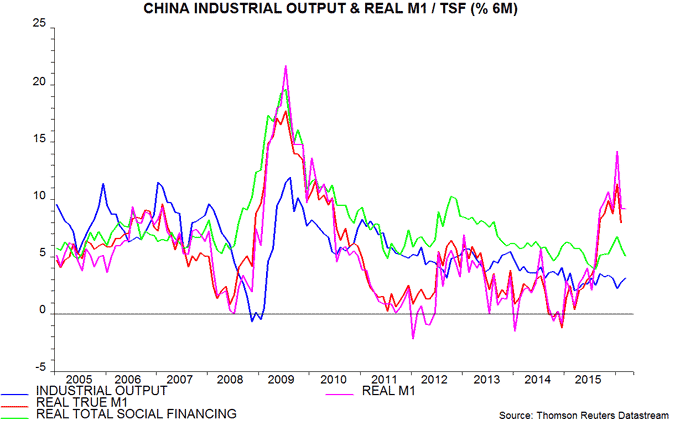Chinese recovery confirmed, money signal still positive
Chinese economic reports today confirm a recovery predicted by monetary trends, which continue to give a positive signal, though are no longer strengthening.
Headline activity data matched or beat consensus expectations but may have been flattered by calendar effects. Annual growth of nominal GDP rebounded from 6.0% in the fourth quarter, the lowest since 1999, to 7.1% in the first quarter. A turnaround had been suggested by a strong acceleration of narrow money, as measured by the “true M1” aggregate* calculated here, from mid-2015 – see first chart. The increase, however, was probably boosted by an extra calendar day due to the leap year.
Annual growth of industrial output rose from 5.4% in January / February to 6.8% in March, well above a 5.9% consensus prediction. A previous post argued that the earlier timing of the Chinese New Year in 2016 versus 2015 depressed January / February growth relative to the underlying trend and was likely to deliver a compensating overshoot in March. This suggests a partial relapse in April data, which will give a better indication of the extent of trend improvement.
Annual growth of fixed asset investment rose to 11.1% in March, the highest since June 2015. The pick-up, however, has been entirely government-led, with the annual increase in private investment sliding further to 4.7% last month – second chart. Strong growth of corporate narrow money suggests that private spending will revive soon.
Money and credit expansion remained solid in March. The detail necessary to calculate true M1 is not yet available but annual growth in the official M1 measure surged further to 22.1%, the highest since 2010. This partly reflected a favourable base effect, so a reversal is likely in April. Annual M2 growth was little changed at 13.4% – third chart.
Pessismists argue that an economic recovery has been achieved only by engineering another credit splurge. Annual growth of the stock of “total social financing” (TSF) (i.e. bank loans and other domestic fund-raising by households and non-financial enterprises) has risen from a low of 12.0% in June 2015 to 13.4% in March but remains well below the average in recent years – third chart**. Faster expansion of narrow money than credit is normally a positive signal for the economy and markets.
The economic forecasting approach here focuses on six-month growth of real (i.e. inflation-adjusted) narrow money. Based on the official M1 data, this remained strong in March but has moved sideways since late 2015, suggesting a stabilisation of economic growth at a higher level in the second half of 2016 – fourth chart.
*True M1 = currency in circulation plus demand / temporary deposits of corporations and households. The official M1 measure omits household deposits.
**Growth of a broader aggregate including local government bonds is stronger but also below its recent average. Domestic credit measures have been inflated by corporations switching away from external borrowing.




Reader Comments